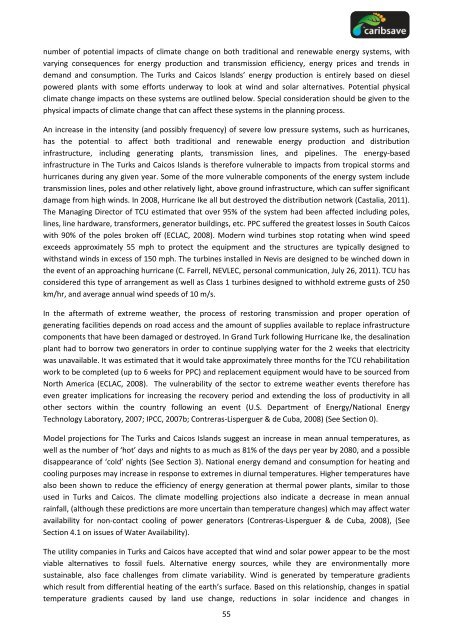Create successful ePaper yourself
Turn your PDF publications into a flip-book with our unique Google optimized e-Paper software.
number of potential impacts of climate change on both traditional <strong>and</strong> renewable energy systems, with<br />
varying consequences for energy production <strong>and</strong> transmission efficiency, energy prices <strong>and</strong> trends in<br />
dem<strong>and</strong> <strong>and</strong> consumption. The <strong>Turks</strong> <strong>and</strong> <strong>Caicos</strong> Isl<strong>and</strong>s’ energy production is entirely based on diesel<br />
powered plants with some efforts underway to look at wind <strong>and</strong> solar alternatives. Potential physical<br />
climate change impacts on these systems are outlined below. Special consideration should be given to the<br />
physical impacts of climate change that can affect these systems in the planning process.<br />
An increase in the intensity (<strong>and</strong> possibly frequency) of severe low pressure systems, such as hurricanes,<br />
has the potential to affect both traditional <strong>and</strong> renewable energy production <strong>and</strong> distribution<br />
infrastructure, including generating plants, transmission lines, <strong>and</strong> pipelines. The energy-based<br />
infrastructure in The <strong>Turks</strong> <strong>and</strong> <strong>Caicos</strong> Isl<strong>and</strong>s is therefore vulnerable to impacts from tropical storms <strong>and</strong><br />
hurricanes during any given year. Some of the more vulnerable components of the energy system include<br />
transmission lines, poles <strong>and</strong> other relatively light, above ground infrastructure, which can suffer significant<br />
damage from high winds. In 2008, Hurricane Ike all but destroyed the distribution network (Castalia, 2011).<br />
The Managing Director of TCU estimated that over 95% of the system had been affected including poles,<br />
lines, line hardware, transformers, generator buildings, etc. PPC suffered the greatest losses in South <strong>Caicos</strong><br />
with 90% of the poles broken off (ECLAC, 2008). Modern wind turbines stop rotating when wind speed<br />
exceeds approximately 55 mph to protect the equipment <strong>and</strong> the structures are typically designed to<br />
withst<strong>and</strong> winds in excess of 150 mph. The turbines installed in Nevis are designed to be winched down in<br />
the event of an approaching hurricane (C. Farrell, NEVLEC, personal communication, July 26, 2011). TCU has<br />
considered this type of arrangement as well as Class 1 turbines designed to withhold extreme gusts of 250<br />
km/hr, <strong>and</strong> average annual wind speeds of 10 m/s.<br />
In the aftermath of extreme weather, the process of restoring transmission <strong>and</strong> proper operation of<br />
generating facilities depends on road access <strong>and</strong> the amount of supplies available to replace infrastructure<br />
components that have been damaged or destroyed. In Gr<strong>and</strong> Turk following Hurricane Ike, the desalination<br />
plant had to borrow two generators in order to continue supplying water for the 2 weeks that electricity<br />
was unavailable. It was estimated that it would take approximately three months for the TCU rehabilitation<br />
work to be completed (up to 6 weeks for PPC) <strong>and</strong> replacement equipment would have to be sourced from<br />
North America (ECLAC, 2008). The vulnerability of the sector to extreme weather events therefore has<br />
even greater implications for increasing the recovery period <strong>and</strong> extending the loss of productivity in all<br />
other sectors within the country following an event (U.S. Department of Energy/National Energy<br />
Technology Laboratory, 2007; IPCC, 2007b; Contreras-Lisperguer & de Cuba, 2008) (See Section 0).<br />
Model projections for The <strong>Turks</strong> <strong>and</strong> <strong>Caicos</strong> Isl<strong>and</strong>s suggest an increase in mean annual temperatures, as<br />
well as the number of ‘hot’ days <strong>and</strong> nights to as much as 81% of the days per year by 2080, <strong>and</strong> a possible<br />
disappearance of ‘cold’ nights (See Section 3). National energy dem<strong>and</strong> <strong>and</strong> consumption for heating <strong>and</strong><br />
cooling purposes may increase in response to extremes in diurnal temperatures. Higher temperatures have<br />
also been shown to reduce the efficiency of energy generation at thermal power plants, similar to those<br />
used in <strong>Turks</strong> <strong>and</strong> <strong>Caicos</strong>. The climate modelling projections also indicate a decrease in mean annual<br />
rainfall, (although these predictions are more uncertain than temperature changes) which may affect water<br />
availability for non-contact cooling of power generators (Contreras-Lisperguer & de Cuba, 2008), (See<br />
Section 4.1 on issues of Water Availability).<br />
The utility companies in <strong>Turks</strong> <strong>and</strong> <strong>Caicos</strong> have accepted that wind <strong>and</strong> solar power appear to be the most<br />
viable alternatives to fossil fuels. Alternative energy sources, while they are environmentally more<br />
sustainable, also face challenges from climate variability. Wind is generated by temperature gradients<br />
which result from differential heating of the earth’s surface. Based on this relationship, changes in spatial<br />
temperature gradients caused by l<strong>and</strong> use change, reductions in solar incidence <strong>and</strong> changes in<br />
55





